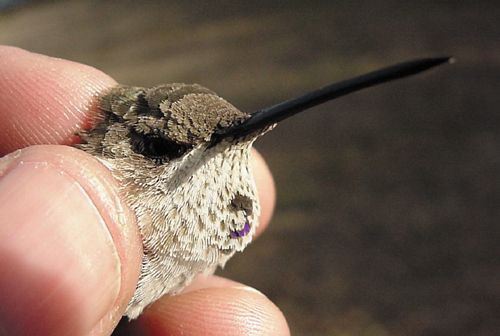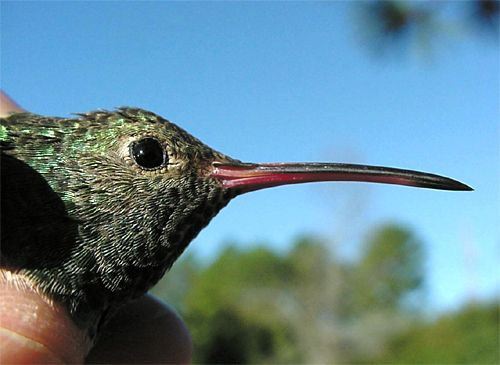|
|
|||
|
|
|||
|
WHAT'S WITH ALL THESE For generations, gardeners in the eastern U.S. and southern Canada have had an affinity for Ruby-throated Hummingbirds that visit well-tended plantings all during the growing season. Early April through mid-October, plant enthusiasts delight in their tiny featherballs and sometimes cultivate special flowers that attract even more hummers. Thus, it's understandable that horticulturists lament fall days when the last hummingbird departs in migration and the last flower wilts and dies. There's no doubt that some western hummers wandered eastward in late autumn well before the invention of plastic hummingbird feeders. Records of winter sightings in the southeastern United States go back at least until the early 1900s, and in that region through about 1980 there are nearly 100 acceptable reports of probable Rufous Hummingbirds (immature male above right; also see bottom photo). In the past 25 years, such sightings have skyrocketed, and now hundreds of western vagrant hummingbirds are reported every winter from the eastern half of the U.S. Already in 2003 we're aware of Rufous Hummingbird reports from 132 counties or parishes in 25 states east of the Rocky Mountains, and the winter season is just getting started! The big question is whether the number of wintering hummingbirds is increasing or whether folks are just getting better at attracting, observing, and reporting them. Ruby-throated Hummingbirds, Archilochus colubris--our summer breeders in the eastern U.S.--are not very cold-tolerant, and nearly all of them bail out each autumn to spend the winter in tropical Mexico or Central America. Those few that remain typically occur in coastal states where the maritime effect makes weather less severe. By comparison, Rufous Hummingbirds, Selasphorus rufus--which breed in southern Alaska, western Canada, and the northwestern U.S.--see freezing temperatures upon occasion even on their nesting grounds, so making it through the winter in the eastern U.S. when there's a little snow on the ground probably doesn't seem like an impossible challenge.
 Although Rufous Hummingbirds are the only vagrants we've banded at Hilton Pond Center, they aren't the only winter species in the East. North Carolina now has ten species on its unofficial list and South Carolina claims eight; several of these have been seen only once, and most arrive after our summer-resident ruby-throats depart. So far we've banded two vagrant hummingbird species elsewhere within York County--the Center's home base--including 11 Rufous (at ten different locations) and a tiny immature male Calliope (at Bethany, about ten miles from York, photo above left). At other sites in South Carolina we've also trapped an immature male Black-chinned Hummingbird (Columbia, photo just above) and the state's first and only Buff-bellied Hummingbird (near Lexington, photo below). Calliopes and Black-chinneds are both western U.S. breeders that winter in Mexico like the Rufous, but the Buff-bellied nests along the warm and sunny Gulf Coast from south Texas to Belize and would seem to have no reason to migrate. What our red-billed Buff-bellied Hummingbird was doing in central South Carolina in early December 2001 is anyone's guess.  Actually, explaining why ANY of our winter vagrant hummers appear hundreds--even thousands--of miles north and east of their historical wintering grounds is pure speculation. We suspect the perceived "increase" in vagrant winter hummingbirds is due to a combination of factors, some of which are mentioned above and reiterated below:
Regardless of which of these factors--or perhaps others that we haven't considered--might result in increased sightings, it's important that observers report any and all winter hummers for capture and verification. Without in-the-hand measurements by a certified hummingbird bander, it's often not possible to know a vagrant hummingbird's species; without a numbered band on the bird's leg there's no way to know the hummer's origin or its final destination; and, without identification and banding data, our job of understanding what these little birds are doing is far harder, maybe impossible. Thus, we ask you to spread the word about reporting any vagrant hummingbird to RESEARCH so we can travel to band it, or so we can contact another bander closer to where the hummer has been seen. Perhaps through the collective efforts of banders and the public we'll someday find the answer to this week's question at Hilton Pond: "What's with all these winter hummingbirds?"  Hatch-year male Rufous Hummingbird (November 2003) Hatch-year male Rufous Hummingbird (November 2003)NOTE: For a complete list of all vagrant hummingbirds we've banded in the Carolinas--plus suggestions for how to maintain a winter feeding station--see Vagrant & Winter Hummingbird Banding; this link includes some information from the account above. For excellent maps that show reports of vagrant hummingbirds, visit Stacy Jon Peterson's Trochilids Web Page. "This Week at Hilton Pond" is written and photographed by Bill Hilton Jr., executive director of Hilton Pond Center for Piedmont Natural History. just send us an e-mail with "Subscribe" in the subject line. |
|
Make direct donations on-line through
Network for Good: |
|
|
LIKE TO SHOP ON-LINE?
Donate a portion of your purchase price from 500+ top on-line stores via iGive: |
|
|
Use your PayPal account
to make direct donations: |
|
|
|
|
SPECIES BANDED THIS WEEK: * = New species for 2003 WEEKLY BANDING TOTAL 2 species 7 individuals
YEARLY BANDING TOTAL (2003) 61 species 1,003 individuals
BANDING GRAND TOTAL (since 28 June 1982) 123 species 43,117 individuals
NOTABLE RECAPTURES THIS WEEK (with original banding date, sex, and current age) Carolina Chickadee (1) 03/29/02--2nd year male Tufted Titmouse (1) White-throated Sparrow (1) Eastern Towhee (1) |
OTHER SIGHTINGS OF INTEREST
VAGRANT HUMMINGBIRDS --None banded this week. |
|
|
|
Up to Top of Page Back to This Week at Hilton Pond Center Current Weather Conditions at Hilton Pond Center |
 post questions for The Piedmont Naturalist |
Join the |
Search Engine for |
|
|